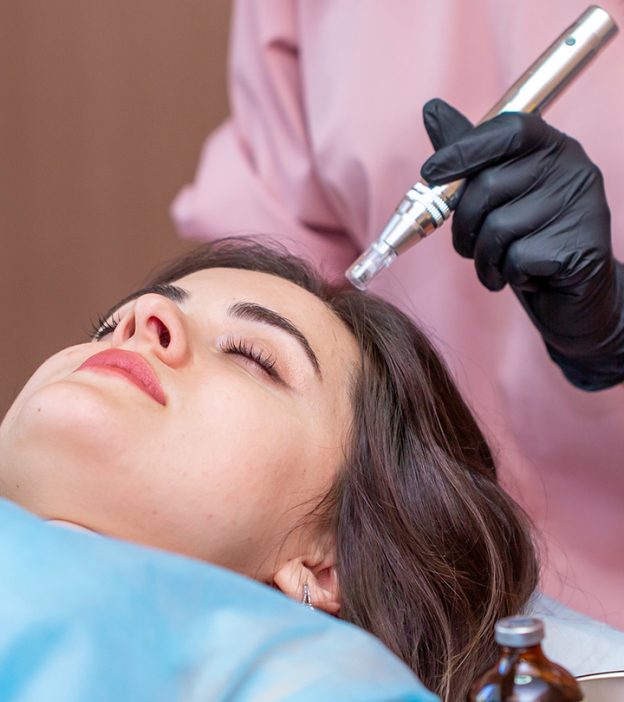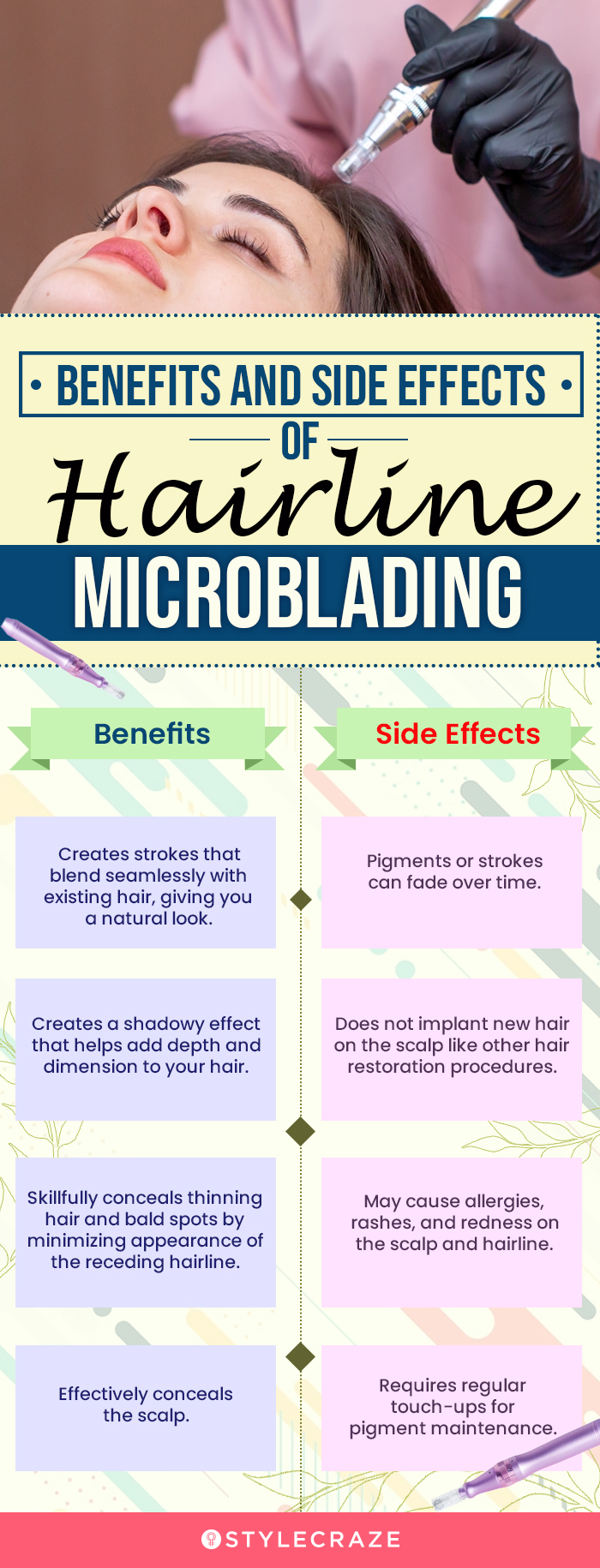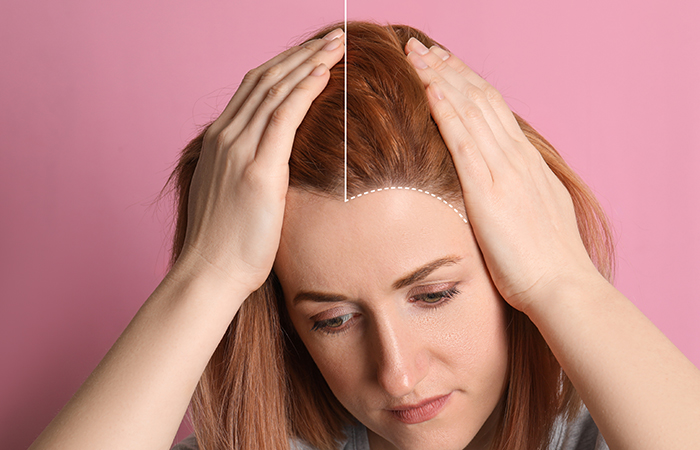Hairline microblading is a popular treatment for receding hairlines, with women often targeting the temples, front hairline, and part, while men typically focus on the temples and the crown. The procedure aims to reduce the appearance of thinning or receding hairlines and boost confidence by creating the illusion of hair follicles through semi-permanent tattoo lines.
However, it’s important to consider the downsides of hairline microblading, such as the potential for imprecise results and the discomfort of the procedure. Understanding the benefits and drawbacks of hairline microblading can help individuals make an informed decision about whether it is the right choice for them.

Benefits Of Hairline Microblading
Understanding the benefits of hairline microblading can help you make an informed decision about whether this treatment is right for you. Hairline microblading offers a range of advantages, including:
Natural-looking Results
One of the key benefits of hairline microblading is the natural-looking results it provides. The microblading technique involves creating individual hair strokes that mimic the appearance of real hair. This meticulous process ensures that the treatment blends seamlessly with your existing hairline, creating a natural and undetectable result.
Boosts Confidence
Another significant benefit of hairline microblading is the confidence it can give you. A receding or thinning hairline can have a negative impact on your self-esteem, making you feel self-conscious and insecure. Hairline microblading can help address these concerns by filling in sparse or empty areas, creating the illusion of a fuller hairline. This can boost your confidence and improve your overall self-image.
Reduces The Appearance Of A Receding Or Thinning Hairline
One of the primary goals of hairline microblading is to reduce the appearance of a receding or thinning hairline. This treatment is especially beneficial for individuals who have thinning hair or are experiencing hair loss. By strategically placing hair-like strokes along the hairline, microblading can create the illusion of denser and fuller hair, giving you a more youthful and balanced appearance.
In conclusion, hairline microblading offers various benefits, including natural-looking results, a boost in confidence, and the reduction of a receding or thinning hairline. If you are looking to improve the appearance of your hairline and restore your confidence, hairline microblading may be a suitable option for you.
Downsides Of Hairline Microblading
While hairline microblading has gained popularity as a solution for receding or thinning hairlines, it is important to be aware of the potential downsides of this procedure. In this section, we will explore some of the negative effects on hair growth, the lack of precision, and the painful nature of this procedure.
Negative Effects On Hair Growth
One of the main concerns with hairline microblading is its potential negative impact on natural hair growth. The microblading process involves implanting pigments into the skin to create the appearance of hair follicles, which can sometimes interfere with the growth of existing hair. While the results may initially seem impressive, there is a risk that the implanted pigments can affect the natural hair follicles and potentially hinder their growth. It is important to consider this aspect before deciding whether to undergo hairline microblading.
Lack Of Precision
Another downside of hairline microblading is the lack of precision that can occur during the procedure. Expertise and skill are crucial in achieving natural-looking results, but even with the most experienced technician, there is always a chance of slight imperfections. The process involves manually drawing hair strokes, which may not always align perfectly with the existing hairline or create a seamless appearance. This lack of precision can lead to dissatisfaction with the final outcome.
Painful Procedure
It is important to note that hairline microblading can be a painful procedure for some individuals. During the session, a handheld tool with multiple microblades is used to make small incisions into the skin, which can cause discomfort and even mild to moderate pain. While a numbing cream is typically applied beforehand, some individuals may still experience discomfort during the procedure. It is essential to have realistic expectations about the potential pain involved in hairline microblading.
How Hairline Microblading Works
Hairline microblading works by carefully blending semi-permanent tattoo lines with the existing hair, aiming to reduce the appearance of a receding or thinning hairline. This treatment is popular for both men and women, with areas such as the temples, front hairline, and part being commonly targeted.
The Process Of Blending Semi-permanent Tattoo Lines With Existing Hair
Hairline microblading is a revolutionary technique that involves blending semi-permanent tattoo lines with existing hair to create the illusion of a fuller and more defined hairline. This procedure is ideal for individuals experiencing receding hairlines, thinning hair, or those who simply want to enhance the appearance of their hairline.
The process starts with a consultation session with a professional microblading artist. During this session, the artist will assess the client’s hairline and discuss their desired outcome. They will also explain the procedure in detail and address any concerns or questions the client may have.
Before starting the microblading process, the artist will numb the area to ensure the client’s comfort. Then, using a handheld microblading tool with tiny needles, the artist creates precise hair-like strokes on the scalp. These strokes are carefully placed and blended with the client’s existing hair, giving it a natural and realistic appearance.
Difference Between Microblading And Micropigmentation
Microblading and micropigmentation are both effective techniques for enhancing the appearance of the hairline, but there are some key differences between the two.
Microblading is a manual technique that uses a handheld tool to create fine, hair-like strokes on the scalp. It is typically done with organic pigments that match the client’s hair color, resulting in a natural-looking hairline. Microblading is a semi-permanent solution and may require touch-ups every 1-2 years.
On the other hand, micropigmentation, also known as scalp micropigmentation (SMP), involves the use of a specialized machine to deposit pigments into the scalp. This technique creates the illusion of thousands of tiny hair follicles, giving the appearance of a full head of hair. Micropigmentation is a longer-lasting solution and usually requires fewer touch-ups compared to microblading.
Choosing Between Scalp Micropigmentation And Microblading
When deciding between scalp micropigmentation and microblading for your hairline, it’s essential to consider your individual needs and preferences.
Scalp micropigmentation may be a better choice if you are looking for the more dramatic appearance of a full head of hair. This technique can effectively camouflage bald patches and create a defined and realistic hairline. SMP also requires less maintenance and fewer touch-ups, making it a convenient option for individuals with a busy lifestyle.
On the other hand, microblading is a great option if you desire a more natural-looking hairline. The fine, hair-like strokes created during the process blend seamlessly with your existing hair, giving a realistic and subtle result. Microblading also provides you with the flexibility to adjust the shape and density of your hairline according to your preferences.
In conclusion, both scalp micropigmentation and microblading can significantly improve the appearance of your hairline. It’s crucial to consult with a professional to determine which technique would suit you best based on your goals and personal preferences.


Frequently Asked Questions On Hairline Microblading: Benefits, Downsides, And How It Works
Does Microblading Work On Hairline?
Microblading can work on the hairline, especially for women dealing with receding hairlines. It is a popular treatment for temples, front hairlines, and the part. Men also opt for microblading on their temples and crown areas. Microblading for the hairline involves drawing hair strokes on the eyebrow to create the illusion of fuller hair.
What Is The Aftercare For Hairline Microblading?
Aftercare for hairline microblading is crucial for optimal results. Here are some guidelines to follow: 1. Gently clean the treated area twice a day using a mild cleanser and water. 2. Avoid touching or scratching the area to prevent infection.
3. Apply a thin layer of recommended ointment or moisturizer to keep the skin hydrated. 4. Avoid direct sun exposure and use sunscreen when going outside. 5. Avoid sweating excessively and swimming for at least two weeks. Following these steps will ensure proper healing and longevity of your hairline microblading.
How Much Is Microblading Hairline?
The cost of microblading for a hairline varies. Please contact a reputable microblading salon or practitioner for pricing information.
What Is The Difference Between Microblading And Micropigmentation For Hairline?
Microblading creates the illusion of hair strokes on the eyebrow, while micropigmentation, also known as a scalp tattoo, creates the illusion of hair follicles on the head.
Conclusion
To summarize, hairline microblading can be a game-changer for individuals dealing with receding or thinning hairlines. By carefully blending semi-permanent tattoo lines with existing hair, this treatment can create a natural-looking and fuller appearance. Although there may be downsides such as discomfort and potential negative effects on hair growth, the benefits of boosted confidence and improved aesthetics make hairline microblading worth considering.
Whether it’s for women focusing on the temples and front hairline or men seeking all-over coverage, this procedure offers a solution for those looking for a non-surgical hair restoration option.
DIY hair oils are some of the most important ingredients to have in your beauty arsenal. They add shine, manage frizzy hair, and help improve your hair health.